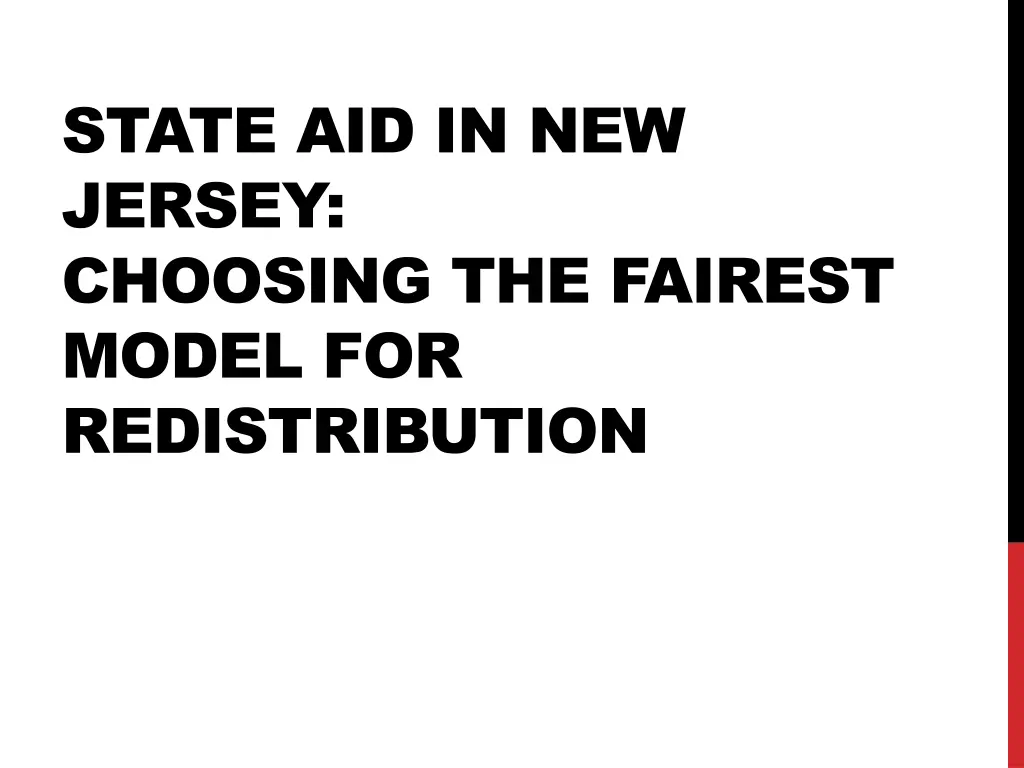
Fairest Model for State Aid Redistribution in New Jersey
Exploring the redistribution of state aid in New Jersey, focusing on the Equalization Aid model under the SFRA law. Learn about the Adequacy Budget, Local Fair Share, and challenges faced in implementing fair distribution. Discover the complexities and considerations in determining aid for different districts.
Download Presentation

Please find below an Image/Link to download the presentation.
The content on the website is provided AS IS for your information and personal use only. It may not be sold, licensed, or shared on other websites without obtaining consent from the author. If you encounter any issues during the download, it is possible that the publisher has removed the file from their server.
You are allowed to download the files provided on this website for personal or commercial use, subject to the condition that they are used lawfully. All files are the property of their respective owners.
The content on the website is provided AS IS for your information and personal use only. It may not be sold, licensed, or shared on other websites without obtaining consent from the author.
E N D
Presentation Transcript
STATE AID IN NEW JERSEY: CHOOSING THE FAIREST MODEL FOR REDISTRIBUTION
BACKGROUND: NJS STATE AID IS SUPPOSED TO BE DISTRIBUTED ACCORDING TO A LAW CALLED SFRA The most important stream of state aid is Equalization Aid. Equalization Aid is the difference Adequacy Budget and Local Fair Share, so: Adequacy Budget - Local Fair Share = Equalization Aid Adequacy Budget is a demographic measure of a district s needs. It depends mostly on population, # of FRL-eligible children, and # of ELLs. Local Fair Share is an economic measure of a district s ability to pay taxes. It depends on Total Income and Equalized Valuation. There are categorical aids like Sped Aid, Transportation Aid, and Security Aid which go to all districts, even wealthy ones.
HOW EQUALIZATION AID IS SUPPOSED TO WORK Example: If a district s Adequacy Budget is $80 million and its Local Fair Share is $20 million, it would get $60 million in Equalization Aid plus Sped, Transportation, and Security Aid. If a district s Local Fair Share is greater than its Adequacy Budget the district does not receive Equalization Aid. How Equalization Aid is Supposed to Work Adequacy Budget Equalization Aid Local Fair Share $60 $80 $20 1 2
APPROXIMATE ADEQUACY BUDGET PER STUDENT FOR ESSEX COUNTY TOWNS Millburn, 2% FRL, 1% LE $14,143 South Orange-Maplewood, 20% FRL, 1% LE $15,764 West Orange, 38% FRL, 4% LE $16,452 Bloomfield, 43% FRL, 4% LE $17,594 Belleville, 59% FRL, 5% LE $18,603 Newark, 84% FRL, 9% LE $20,070
SFRA WAS SUPPOSED TO BE PHASED IN OVER SEVERAL YEARS How SFRA Was Supposed to be Phased In Aid Level of Year Previous to SFRA New Capped Aid Uncapped Aid $14 $14 $12 $10 $100 $86 $72 $60 $50 $50 Pre-SFRA What SFRA says it needs Year 1 Year 2 Year 3 Year 4 (Full Uncapped Funding)
FACING NJS BUDGETARY REALITY, COMM. HESPE AND SEN. PRES. STEVEN SWEENEY RECENTLY ACKNOWLEDGED THE NEED TO REDISTRIBUTE SOME STATE AID There are difficult decisions to be made [on state aid] and, without your input, we ll probably end up making the wrong ones. - David Hespe "There are some districts that get more money than they are entitled to," he said. "We are going to have pretty serious discussions, and a lot of people won't like it." - Steven Sweeney
REDISTRIBUTION COULD BE FAIR BECAUSE NUMEROUS DISTRICTS GET MORE MONEY THAN SFRA SAYS THEY NEED How Adjustment Aid Sustains High Aid for an Overaided District Formula Aid Adjustment Aid $42 $42 $44 $45 $100 $60 $60 $60 $58 $57 Pre-SFRA What SFRA says it needs Year 1 Year 2 Year 3 Year 4
220 DISTRICTS GET 100% OR MORE OF THEIR UNCAPPED AID Actual Aid versus Uncapped Aid Per Student for Select Overaided Districts $25,000 $20,000 $15,000 $10,000 $5,000 $0 Ocean Twp Asbury Park Pemberton Jersey City Hoboken Toms River Reg. Randolph Marlboro Hillsborough
THE SOMSD ONLY GETS 46% OF ITS UNCAPPED AID Uncapped Aid versus Actual Aid for the SOMSD $10,000,000 $9,000,000 $8,000,000 $7,000,000 $6,000,000 $5,000,000 $4,000,000 $3,000,000 $2,000,000 $1,000,000 $0 Uncapped, $9 mil Actual, $4.2 mil Equalization Aid Transportation Security Special Education Other Aids
THIS IS VERY LOW IN PERCENTAGE TERMS, BUT NOT DOLLARS PER STUDENT Actual Aid per student versus Capped Aid per student for selected underaided districts $20,000 $18,000 $16,000 $14,000 $12,000 $10,000 $8,000 $6,000 $4,000 $2,000 $0
IF AID WERE REDISTRBUTED BASED ON UNCAPPED AID IT WOULD BE PROGRESSIVE AND GOOD OR HARMLESS FOR HIGH TAX DISTRICTS LIKE THE SOMSD
IF AID WERE REDISTRIBUTED BASED ON DISTRICTS BEING ABOVE ADEQUACY THE SOMSD COULD LOSE AID A district can be underaided but Above Adequacy due to the acceptance of a high taxes. High Taxes Can Keep an Underaided District Above Adequacy: Hypothetical $4,000 $3,000 $3,000 $2,000 $1,000 $1,000 $- Spending Relative to Adequacy Budget Aid Relative Uncapped Aid Taxes Relative to LFS $(1,000) $(2,000) $(2,000) $(3,000)
THE SOMSD IS AT OR ABOVE ADEQUACY The SOMSD Budget Compared to its Adequacy Budgets (in millions) $130.0 $117.6 $120.0 $114.5 $107.9 $110.0 $100.0 $90.0 $80.0 $70.0 $60.0 Adequacy Budget (for EV) Adequacy Budget (with Cat. Aids) Total Operating Budget
Redistribution of aid is necessary, but we have to be watchful of the method used. Redistribution based on uncapped aid is the most consistent with SFRA and is good or neutral for high-tax districts like the SOMSD. Redistribution based on Adequacy Budget would hurt districts that tax themselves heavily and reward districts that do not accept their Local Fair Shares.
